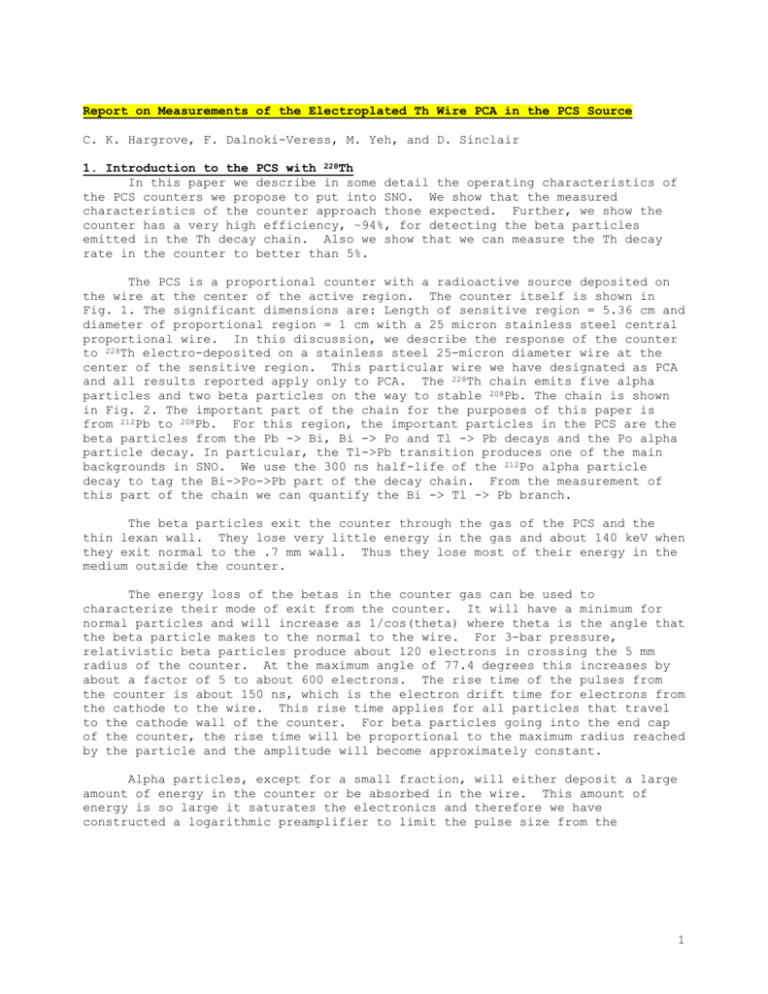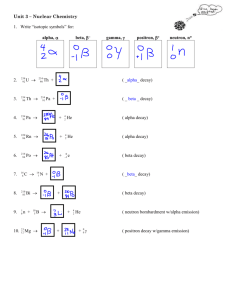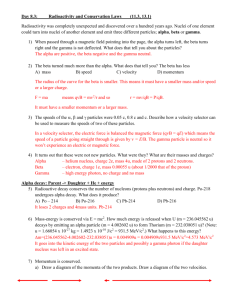Report on Measurements of the Electroplated Th Wires in the PCS
advertisement

Report on Measurements of the Electroplated Th Wire PCA in the PCS Source C. K. Hargrove, F. Dalnoki-Veress, M. Yeh, and D. Sinclair 1. Introduction to the PCS with 228Th In this paper we describe in some detail the operating characteristics of the PCS counters we propose to put into SNO. We show that the measured characteristics of the counter approach those expected. Further, we show the counter has a very high efficiency, ~94%, for detecting the beta particles emitted in the Th decay chain. Also we show that we can measure the Th decay rate in the counter to better than 5%. The PCS is a proportional counter with a radioactive source deposited on the wire at the center of the active region. The counter itself is shown in Fig. 1. The significant dimensions are: Length of sensitive region = 5.36 cm and diameter of proportional region = 1 cm with a 25 micron stainless steel central proportional wire. In this discussion, we describe the response of the counter to 228Th electro-deposited on a stainless steel 25-micron diameter wire at the center of the sensitive region. This particular wire we have designated as PCA and all results reported apply only to PCA. The 228Th chain emits five alpha particles and two beta particles on the way to stable 208Pb. The chain is shown in Fig. 2. The important part of the chain for the purposes of this paper is from 212Pb to 208Pb. For this region, the important particles in the PCS are the beta particles from the Pb -> Bi, Bi -> Po and Tl -> Pb decays and the Po alpha particle decay. In particular, the Tl->Pb transition produces one of the main backgrounds in SNO. We use the 300 ns half-life of the 212Po alpha particle decay to tag the Bi->Po->Pb part of the decay chain. From the measurement of this part of the chain we can quantify the Bi -> Tl -> Pb branch. The beta particles exit the counter through the gas of the PCS and the thin lexan wall. They lose very little energy in the gas and about 140 keV when they exit normal to the .7 mm wall. Thus they lose most of their energy in the medium outside the counter. The energy loss of the betas in the counter gas can be used to characterize their mode of exit from the counter. It will have a minimum for normal particles and will increase as 1/cos(theta) where theta is the angle that the beta particle makes to the normal to the wire. For 3-bar pressure, relativistic beta particles produce about 120 electrons in crossing the 5 mm radius of the counter. At the maximum angle of 77.4 degrees this increases by about a factor of 5 to about 600 electrons. The rise time of the pulses from the counter is about 150 ns, which is the electron drift time for electrons from the cathode to the wire. This rise time applies for all particles that travel to the cathode wall of the counter. For beta particles going into the end cap of the counter, the rise time will be proportional to the maximum radius reached by the particle and the amplitude will become approximately constant. Alpha particles, except for a small fraction, will either deposit a large amount of energy in the counter or be absorbed in the wire. This amount of energy is so large it saturates the electronics and therefore we have constructed a logarithmic preamplifier to limit the pulse size from the 1 2 Figure 1 Figure 2: Ealpha Po = 7.87 MeV, Bi =6..09, Qbeta Bi =2.245 MeV preamplifier. Its logarithmic response allows us to measure low amplitude beta particles in the presence of high amplitude alpha particles. In order to Quantify the response of the PCS to the Th chain, we have surrounded it with a scintillation counter (SC). Then we have examined the pulse height spectrum produced by the source in the counter under a number of conditions both in coincidence with the SC and in the singles mode. A coincidence between the SC and the PCS requires that a beta or gamma ray is emitted from the Th source and detected in the SC and at the same time some energy is deposited in the PCS. Since the alpha particles cannot get through the lexan wall of the counter, they will themselves produce no coincidences. Also, the efficiency of the thin-walled SC is low for gamma rays, so we do not have a high rate from them. In this note, we report the results from the acquisition of the following spectra: 1. The beta.alpha(del): This coincidence selects a beta particle pulse in the PCS that is followed by an alpha particle pulse in the PCS within the 300 ns lifetime of the Po state. This uses the PCS pulses to self-select the Bi->Po->Pb decay. 2. The beta.alpha(del).SC: A coincidence is demanded between the SC and the beta.alpha(delayed) sequence in the PCS. The ratio of this rate to the rate of the above delayed coincidence gives the SC efficiency for beta particles from the Bi -> Po decay since a beta particle from this decay always precedes the delayed alpha particle from the Po decay. 3. The SC.alpha(del): This is the coincidence between the SC and a delayed alpha particle seen in the PCS. This also selects the same decay but does not require there be a beta particle in the PCS. 4. The SC.alpha(del).beta: This is a coincidence between the coincidence of number three above and a beta particle seen in the PCS. The ratio of this rate to the rate for #3 above is the efficiency of the PCS for the Bi -> Po betas. 3 5. 6. 7. The SC.pcs: This is a coincidence between any SC pulse and any PCS pulse. This selects all decays from the Th source on the wire that produce signals in both the PCS and in the SC. The singles spectrum triggered by a low level discriminator. This gives the full spectrum seen in the PCS. The singles spectrum triggered by a high level discriminator. This discriminator is used to select the alpha particles in the coincidence logic. This spectrum is used to calibrate the alpha particle discriminator setting. The pulse height analyzer system has a long time constant and sums the pulse heights from the beta and alpha decay of the Bi->Po->Pb decay chain. Therefore we do not separately see the beta and alpha particle pulse heights of the Bi->Po->Pb chain, only their sum. Using the rates for the above spectra we can get quantitative information about the PCS and the Th source. This information is described in detail in association with Table 1 below. 2. RESULTS: Pulse Height Spectra 2.1 The Blank Cartridge (No Source) As a test, we have first measured the response of a cartridge with no source deposited on the wire. The background rate in such a counter was < 1Hz. To measure the resolution and uniformity of gain of a PCS without Th on the wire, we took a 55Fe spectra. Such a spectrum is shown in Fig. 3. 4 55Fe Spectrum 500 450 400 350 Counts 300 250 200 150 100 50 0 0 200 400 600 800 1000 1200 Channel Number Fe showing the 6 keV X-ray and the Ar double escape peak at 3 keV. Fig. 3 The Spectrum of 55 The 6 keV peak from the Fe and the low energy peak at 3 keV from the escape of the Ar X-ray of the counter gas are seen clearly. Of particular note is the low level of the background either above or below these peaks. As a further test, we checked the counter gain as a function of position along the wire by measuring the pulse height of the Fe peak at a number of positions along the wire. The peak channel number of the 6 keV X-ray did not change. Therefore the wire gain was constant within a few per cent. 2.2 Source PCA All the results in this document refer to measurements made on a source we have labeled PCA. This source was made by electro-deposition of 228Th over a 2-mm length at the center of a 25-micron stainless steel wire. Production of 228Th-coated Wire Electro-deposition is the technique used to prepare good quality alpha particle counting sources. The radioisotopes of interest are commonly deposited on polished stainless steel discs by electrochemical reduction of soluble ions in the solution to insoluble forms that interact with the surface of the metal. In 5 this application, a 25-micrometer diameter stainless steel wire was used as the cathode in the electrochemical apparatus for 228Th deposition. A platinum electrode, used as the anode, was cleaned in concentrated hydrochloric acid, and then thoroughly washed with distilled water. Two milliliters of 228Th standard solution (60 Bq.ml-1) were evaporated to dryness. The residue was then dissolved in 5 ml of 0.75M H2SO4 and transferred to a 20-ml beaker. The solution was adjusted to pH~2 with NH4OH; its final volume was nearly 10 ml. The 25-micrometer stainless steel wire was mounted on a 20-cm long Teflon tube in such a way that only a few millimeters of the wire were in contact with the 228Th-containing solution. The electrolysis was carried out at 90 mA for 4 hours and the D.C. voltage ranged from 25 to 30 V. The relatively low current is important to avoid heating the liquid and causing some possible loss of yield. The final size of the deposit was about 3 mm in length on the surface of the stainless steel wire. Over 90% of 228Th in the solution was deposited on the wire. The radon daughter grew into full equilibrium activity (95%) on the wire and was retained quantitatively in the deposit for several months at ambient temperature. The platinum black (1), which was derived from the anode during the electrolysis, was deposited in a thin film on the cathode and was responsible for the enhanced retention of 228Th on the wire and its ingrowing daughters, particularly 220Rn. In initial tests, a few micrograms of dissolved platinum were added to the electrolyte medium to optimize the retention of radioactivity on the wire. It was found however that, with this additional platinum, the thickness of the deposited film increased to some tens of micrometers. This increased depth of the deposited layer was found to reduce the gain of the proportional counter when the voltage was applied. This loss of gain was high enough to affect the efficiency for counting the electrons that were formed in the counter gas by the ionizing radiation from 228Th. Thus no additional dissolved platinum was used in the production of the 228Th-coated wire. In essence, the 228Th deposited on wire is weightless. A detailed study was done of the electrodeposition efficiency and retention ability for 228Th-coated wires produced under the above electrolysis conditions. The losses of thorium daughters by -decay recoil and, particularly of radon by emanation, were observed by measuring the activities of ingrown 228Th daughters and comparing the 220Rn/224Ra activity ratio, respectively, with a Si(Au) surfacebarrier detector, over a period of a few months after the 228Th source preparation. These results will be discussed in another publication (2). Wire Scan The wire was loaded into a PCS cartridge and tested for its quality as a SNO source. The first test was to scan it with the 55Fe source to check the effect of the source deposition on the operation of the counter. We measured the Fe peak position, the Fe peak rate and the total rate for the spectrum as a function of position along the wire. The results are shown in Fig. 4. There was a small loss of gain at the position of the deposition, 25 mm in Fig. 4, as shown by the change in the amplitude of the 55Fe peak. This loss of gain was not enough to affect the efficiency of the counter for the electrons. As seen below neither the peak rate nor the total rate showed any change as a function of The Fe source position along the wire. 6 55Fe Scan of PCA 700 Peak Position (Ch) of Rate (Hz) 600 500 400 300 200 100 0 10 15 20 25 30 35 40 Source Position (mm) Peak Channel Gross Rate (Hz) Peak Rate (Hz) Figure 4 Total Spectrum The full spectrum of pulses seen in the PCS from the Th source is shown in Fig. 5. 7 PCS PULSE HEIGHT SPECTRUM (149) 2500 2000 Counts 1500 Series1 1000 500 0 0 200 400 600 800 1000 Channel Number Figure 5 Figure 5 shows the main characteristics of the counter response to the source. It is taken at 46-psi of P10 gas at 2300 volts. For this description we largely ignore the large bump at high channel numbers. This is due to the alpha decays in the Th chain and here we are mainly interested in the low amplitude pulses from the beta particles. In the beta part of the spectrum there is a short initial plateau followed by a rise to a broad peak at the beginning of the spectrum. Then there is a long tail followed by a rise at high pulse heights. These characteristics are explained as follows: 1. The beta particles from the wire have a minimum loss for those that go normal to the wire and exit the counter at the center. This means there is a minimum pulse height. This is what causes the rise at the low end of the pulse height spectrum. The solid angle is a maximum for these particles and that is why the spectrum rises to a maximum just above this rise. 2. As the electron emission angle moves away from the normal to the wire, the track of the beta in the gas becomes longer and the amplitude of the pulses from the counter increase. The long slow tail reflects the way in which the solid angle changes with particle emission angle. 3. The bump at the highest amplitudes is due to the alpha particle spectrum. The high ionization from these particles saturates even the logarithmic 8 response of the preamplifier. The rather sharp peak in the middle of the smoother bump is a technical effect due to the overloading of the preamplifier. The Alpha Particle Spectrum Fig. 6 shows the same spectrum taken with the pulse height analyzer gated by the alpha particle discriminator. This shows the cutoff setting of the alpha particle discriminator. Alpha Pulse Height Spectrum (PCA_154) 2500 2000 Counts 1500 1000 500 0 0 200 400 600 800 1000 1200 Channel Number Figure 6 The Beta.Alpha(del) Spectrum With the electronic logic, we produce a gating signal for the pulse height analyzer that demands a low amplitude pulse in coincidence with a delayed high amplitude pulse. This condition selects the Bi->Po->Pb decay sequence of the Bi decay since the Po has a 300ns half-life. For these measurements we have set the delay to select alpha particles which are delayed by >350 ns. The amplifier used to feed the pulse height analyzer has a 2-microsecond time constant. Therefore it cannot separate the beta particle from the alpha particle but produces the spectrum of the sum of the two amplitudes. This spectrum is shown in Fig. 7. 9 Beta.Alpha(del) Pulse Height Spectrum (PCA_155) 100 90 80 70 Counts 60 50 40 30 20 10 0 0 200 400 600 800 1000 1200 Channel Number Figure 7 The Beta.Alpha(del).SC Spectrum This spectrum is the same as the last one except that it requires a SC signal in coincidence with the Beta.Alpha(del) signal. The ratio of the Beta.Alpha(del).Scintillator rate to the Beta.Alpha(del) rate measures the efficiency of the SC for the beta particles from the Bi->Po decay. This efficiency is about 60%. The spectrum is shown in Fig. 8. 10 Beta.Alpha(del).Scintillator (PCA_159) 60 50 Counts 40 30 20 10 0 0 200 400 600 800 1000 1200 Channel Number Figure 8 The PCS.SC Spectrum This spectrum, shown in Fig. 9, includes all coincidences between the PCS and the SC. 11 Beta.Scintillator Pulse Height Spectrum (PCA_160) 160 140 120 Counts 100 80 60 40 20 0 0 200 400 600 800 1000 1200 Channel Number Figure 9 The beta particles mainly come from the Bi and Tl decays although there are some from the Pb->Bi decay. A few other coincidences come from Alpha particles that go to excited states of daughter nuclei that then decay by either electron capture or gamma ray emission with enough energy to trigger the SC. The bump at the top is of course mainly from the alpha particles from the Po->Pb decay summed with their associated beta particles. The peak at low channel numbers is the pulse height spectrum produced by the beta particles in the proportional counter. The low energy part of the spectrum is mostly produced by beta particles from the Pb -> Bi, Bi -> Po and the Tl -> Pb decay. Most of the Bi -> Po decay electrons will have an alpha particle in coincidence with them and will be included in the Alpha peak. However, there will be a contribution to the beta spectrum from those beta particles whose associated alpha particles are absorbed in the wire. We have calculated the fraction of alphas that survive the wire to be 77% using a Monte Carlo program. There is, in addition, a contribution to this peak from the Pb -> Bi beta decay electrons. The fraction of these that reach the SC is calculated by Monte Carlo to be about 1% and we have ignored it. 12 The shape of the alpha spectrum is identical with that from the beta.alpha(del) spectrum since they have the same source. Therefore we have removed the alpha spectrum from PCA_160 by normalizing the beta.alpha(del) spectrum, Fig.9, to the upper part of the SC.PCS spectrum and subtracting it. The resulting spectrum is shown in Fig. 10. Scintillator.PCS Beta Spectrum (PCA_160-PCA_157) 110 90 70 Counts 50 30 10 -10 0 100 200 300 400 500 600 700 800 900 -30 -50 Channel Number Figure 10 We have tried to explain the shape, by simulating the pulse height distribution for Bi->Po beta events for Bi on the wire, including the Landau distribution for the energy loss in the gas and a resolution function to take into account the gain straggling in the PCS. The Chi-squared fitted MC spectrum and the experimentally observed spectrum are shown in Figure 11 below where the free parameters are the amplitude and the horizontal scale. We obtain a Chi-squared value of 1.5, where we attribute the difference from 1 to multiple scattering, and other effects that are not in the MC. 13 1000 Figure 11 Figure 11 : Fit of MC simulated Bi->Po beta spectrum (black) to experimentally obtained spectrum(blue). The SC.Alpha(del) Coincidence This coincidence is useful to measure the efficiency of the beta particles in the proportional counter. If we observe a coincidence between the SC signal and that from a delayed alpha particle then we can be certain (barring chance coincidences) that there should be a beta particle in the proportional counter. Therefore, we measure the rate for this signal and also the rate for a beta particle in coincidence with it and the ratio gives us the beta particle efficiency for the beta particles from the Bi to Po decay. This ratio has been found to be 94% for the counter PCA. It is important to point out that this measurement is independent of any conditions like pulse height selection or efficiency of either the alpha particles or the scintillator. All that is required is that when there is a coincidence between the SC and a delayed large pulse in the proportional counter we know there was a beta particle produced. This measurement has another significance. If all the Bi were on the cathode of the counter the beta efficiency would only be 50%. Therefore a high efficiency means that the Th has stayed on the wire. Therefore our 96% efficiency shows that less than 8% of the Th has migrated to the cathode. (Our fit to the data in Table 1 finds a number consistent with zero.) This limit is not very stringent. If the beta particles were on the wall of the counter their 14 pulse height amplitude would be very broad and have no minimum. Therefore, since the spectrum of the beta particles in Fig. 10 shows a distinct minimum is a further signal that the Th is staying on the wire. 3. RESULTS: Rate Measurements 3.1 PCS Rate Measurements Each of these spectra has rates associated with them and these rates are coupled to the amount of Th in the counter and particularly the amount on the wire. Therefore we have made a set of measurements of these rates and then calculated them from the known properties of the counters and the decay schemes. The rates (in Hz) are given in Table I. Table I The Calculated and Measured Rates for PCA 1 2 3 4 5 6 7 8 9 10 11 12 13 14 15 16 17 18 19 20 22 23 24 25 26 27 28 29 30 31 Isotope Decay Branch Alpha Energy Alpha Eff Alpha Rate Beta Rate Sum Scintillator rate Beta.Alpha Delayed Beta.Alpha Delayed.Scint Scintillator Effic.(Measured) Scint.PCS Total Scint.alpha(del) Scint.alpha(del).beta Beta Effic.(Measured) Rate Calculation Constants Th decay rate (Bq) Th->Ra Ra->Rn Rn->Po Po->Pb Pb ->Bi Bi->Po 1 1 1 1 1 0.64 5423 5686 6288 6779 6044 0.61 0.62 0.64 0.66 116.1 118.3 122.5 126.4 20.13 0.42 191.5 27.9 37.3 0.00 Bi->Tl Po->Pb Tl->Pb 0.36 0.64 0.36 6090 8785 0.63 0.77 43.61 94.69 17.71 68.95 71.4 26.34 30.40 17.70 0.00 191.5 0.8 Beta_Eff_ Pb Beta_Eff_ Bi Beta_Eff_Tl 1.00 1.00 1.00 71.37 18.8 17.7 26.34 Scint_Eff_ Pb 0.00 Scint_Eff_ Bi 0.58 Scint_Eff_Tl** 0.3820 **arbitr scale scale of .81 Excited State Constants Isotope Th->Ra Ra->Rn Rn->Po Po->Pb Pb ->Bi Bi->Po BR(Grnd ) 0.727 0.95 Excited State 1 1 Alpha Energy 5341 5449 5747 Energy (keV) 0.084 0.241 BR 0.267 0.05 0.001 e/gamma 20 0.13 Beta_Eff 1 1 PCA SS wire diam. 0.025mm Sum Rate Meas. Rate Diff. 621.5 326.61 948.1 135.0 30.4 17.7 619 328 947 2.52 -1.39 30.40 17.70 0.58 97.70 18.76 17.66 0.94 0.00 97.7 18.8 17.7 Po Life Time Beta DiscWidth 0.016Alpha Delay SC Delay Bi->Tl Po->Pb Tl->Pb Sums 0.272 Sc Eff -Ferenc 1 Nucleus e-th 6051 pb 0.04 Bi 0.699 Tl 22 1 0.00 0.00 (ns) (ns) (ns) (ns) Meas. 0.05 0.01 0.51 0.42 The complexity of the table reflects the large number of parameters that are involved in the calculation of the rates. In the table, we have calculated the contribution to the rates of each element in the chain separately. Therefore each element has its own column. Further, the type of decay is classified as either alpha or beta particle. We have assumed that we can separate these types in the counter based on their amplitude. The first row lists the initial and final elements of the decay for 15 0.10 0.01 0.49 0.40 300 250 492 467 1 1 which the rate is being calculated. The second row gives the branching ratio (BR) of the parent nucleus for that particular decay. The third row gives the alpha decay energy to the ground state of the daughter nucleus. The fourth row gives the calculated efficiency of the PCS for that alpha using a MC simulation. Each following row contains the calculated rate for each type of decay (alpha, beta, coincidence, etc.) for each decaying isotope. The sum column, the one after the columns for which all the individual transition rates have been calculated, contains the sum of the calculated columns. The next column contains the measured rates for each row. The last column contains the difference between the measured and calculated rates for each row. The numbers in the sum row have been adjusted using a Chi-squared fitting routine in which the Th decay rate, the delay times of the two delayed coincidence measurements and the efficiency of the SC for the Tl beta rays have been allowed to vary. Five of the rows, 5, 6, 9,12,13 have been used to fit those four parameters. The Chi-squared per degree of freedom is about 1. Although the Chi-squared implies a good fit to the data, it has some problems that limit its usefulness. First, we find that the last three fitted numbers have differences of zero. This is certain to happen because the time and electronic delays appear independently in those equations and can be adjusted to give the right value. The numbers of the time delays are consistent with the expected values. Here we expect to be able to improve the measurement of those numbers to get rid of them as variables. The other variable that remains then is the SC efficiency for the Tl beta rays. That has been found to be about 38% or about 81% of that measured for the Bi beta rays when scaled for energy by a Monte Carlo program. This is not unreasonable considering the lower energy of the Tl beta particles. As a result, the main uncertainty in the calculations used in these tables is the alpha particle efficiency. The Monte Carlo calculation does not take into account the build up of material on the wire either from the plating or the operation of the chamber. Therefore we believe the actual Th decay rate is known to better than 5%. This rate is in agreement with measurements of the source with a Ge counter which has an error of 10%. The description of the subsequent rows and the equations used is as follows: Row 5. The alpha particle rate This rate is calculated using the Th decay rate (RTh the common variable of the table), the alpha particle efficiency and the BR. Ralpha (Th->Ra) = RTh * Effalpha *BR Ralpha (Th->Ra) is the calculated Th -> Ra decay rate. RTh is the rate of Th decay on the wire Effalpha is the alpha particle efficiency of the PCS for Th branch of that column. BR branching ratio Row 6. The beta particle rate The calculation uses the Th decay rate, the PCS beta particle efficiency and the branching ratio. In order for an isotope that decays 100% by alpha particle emission to produce a beta ray pulse in the PCS, there had to be an alpha particle transition to an excited state with the alpha particle absorbed by the wire and the excited state decay being detected in the PCS. We have calculated this using the product of the branching ratio to the excited state, the PCS inefficiency for the alpha particle, the electron to gamma-ray conversion coefficient and the PCS conversion electron efficiency. For this case, we have assumed the latter efficiency 16 is 100%. The data for the excited state transitions is included under the column that applies to that transition. A typical equation for this process would be: Rbeta = RTh*BRE*Effbeta*(1- Effalpha ) BRE is the branching ratio of the alpha particle transitions to the first excited state. The other elements of the equation should have their obvious connotations. Row 7. The sum of the beta and alpha particle rates This sum is not used in the comparisons. Row 8. The calculated singles SC rate. The measured rate contains an unknown background and hence cannot be used in a comparison of the measured and calculated data. Row 9. The beta.alpha(del) rate The logic triggers on a beta particle pulse and then waits for a delayed alpha particle following it. This rate applies only to the Bi->Po decay branch. Therefore to calculate it we use the Th decay rate, the alpha and beta particle efficiency and the delay time of the alpha particle gate. The delay time takes into account the losses due to the decays that occur before the gate is opened. R(beta.alpha(del)) = RTh *BR* Effalpha_* Effbeta *exp(-0.693*Tdel/T_half) Tdel is the delay used in the logic to select the alpha particle. We fit this in our fitting routing because of the large variation due to the rise time of the beta particle pulses. T_half is the half-life of the Po state. The two Eff factors are the efficiencies of the alpha and beta particles. Row 10. The beta.alpha(del).SC rate The logic used in this coincidence rate adds the condition to the beta.alpha(del) condition that there be a SC pulse as well. Since we know there is beta particle emission with each beta.alpha(del) pulse, this rate gives the efficiency of the SC for seeing the Bi beta particle. In this case it is about 60%. Row 11. The SC Efficiency This row contains the ratio of the two measurements of row 8 to row 7. That is the efficiency of the SC for the Bi beta rays. This ratio is used in the calculations that require the SC efficiency. Row 12. The PCS.SC rate Here we have calculated and measured the rate for counts in the SC in coincidence with the PCS. This calculation requires the inclusion of the three beta decay branches in the Th chain, Pb, Bi and Tl. We use the Th decay rate, PCS beta particle efficiency, the SC efficiency, for the Pb and Tl branches and also the sum of the Bi beta efficiency and the Po alpha particle efficiency for the Bi->Po branch. PCS.SC(Bi) = RTh *BR(Po)*Effsc_Bi*(Effalpha_Po+EffPCS_beta_Bi .(1-Effalpha_Po)) PCS.SC(Tl) = RTh *BR(Tl)* Effsc_Tl *Effbeta_Tl . The notation should be obvious. The First of these equations (the Bi rate) has two terms. The first term takes into account the rate for the alpha particles being detected in the PCS while the second term takes into account the efficiency for seeing a beta in the PCS when there is no alpha. The alpha particle is missing when the wire absorbs it. The second equation contains two poorly known quantities. The first is the SC efficiency for the Tl beta rays. In a Chi-squared fit to the data we find 17 a value of 81% of the measured efficiency for the Bi to Po transition after is scaled by the efficiency calculated by a MC program. The second is the PCS efficiency for them (assumed to be 1). There is another small and unknown component from the Pb->Bi transition. This has a low energy and the probability of the beta particle making it to the SC and being counted is small enough to ignore. Our Monte Carlo predicts <1%. Row 13. The SC.alpha(del) These coincidences occur for the Bi->Po decay. A SC pulse has a delayed alpha particle (high amplitude) pulse in the PCS following it. The calculation requires the Th decay rate, The Bi->Po branching ratio, the SC efficiency, the Po alpha particle efficiency and the delay losses due to the gating delay. R(beta.alpha(del)) = RTh *BR* Effalpha_* EffSC*exp(.693*Tdel/T_half) This is the same formula as for the beta.alpha(del) rate except the sc efficiency has been substituted for the beta efficiency and the time delay is that of the pulse used for this coincidence. This is a very useful coincidence because if it occurs, it means that there has to be a beta particle in the PCS. Row 14. The SC.alpha(del).beta Rate The ratio of this rate to the above rate gives us the PCS beta particle efficiency. We measure this to be about 94%. Row 15. The Beta Particle Efficiency This number is just the ratio of the measured values in the above two rows and is used in the calculations that require the beta efficiency. We find the beta efficiency of the PCS is ~94%. The parameters used in calculating the rates are given at the bottom of the table. The main variable is the total decay rate of the Th on the wire. The efficiency of the SC is measured for the Bi beta decay and that number is used as the basis for the other efficiencies. It is mainly a measure of the solid angle of the SC. The efficiency of the PCS should be close to 1 and that is what is measured. However, in these equations we have arbitrarily fixed the PCS beta particle efficiencies at 1. The other parameter that is used is the delay constant in the two delayed coincidence measurements. The actual delay is not well established because the time resolution and slewing of the pulses causes a fair amount of slop. Therefore those delays were adjusted in the Chi-squared fit described above. The efficiencies and the time delays have been adjusted by the fit to get the good agreement so this is not an absolute measurement. However the fact that these numbers are so close gives us confidence in the method. For this counter we estimate that we know is absolute rate to better than 5%. 3.2 The Ge measurement of the PCA Th Decay Rate We have measured the Th decay rate using a Ge counter by measuring the intensity of the 238 keV gamma ray from the decay of 212 Pb. We compare the intensity of the gamma ray with the PCS as the source with that from a known amount of Th used as the source. The absolute Th decay rate by this method is 207 Bq. This has an error of about 10%. This is to be compared with the number from the above table of 191 Bq. The numbers agree within the errors. 18 4. Conclusions We have made the following measurements with the associated conclusions. 1. We have measured the background rate in the PCS with no source on the wire and found it to be <1 Hz. 2. We have measured the gain of the PCS over its operational length and found it to be independent of position on the wire. 3. We have measured the gain of PCA over its operational length and found its rate and gain to have only a small dependence on the position of the source along the wire. 4. The spectrum of pulses seen in the PCA confirms that the counter operates in the way we had predicted when it was designed. In particular, a fit of the spectrum taken in coincidence with the SC gives a Chi-squared of 1.5 per degree of freedom for 400 degrees of freedom 5. Triggering on an alpha particle following a beta particle in the PCS from the Bi->Po->Pb decay chain we are able to measure the efficiency of the SC for detecting the beta particles. 6. Triggering on the coincidence between the SC and the delayed alpha particle we are able to measure the beta efficiency of the PCS and find this to be >94%. 7. Using the singles rates in the counter, the delayed coincidence rates mentioned above and the total coincidence rate between the SC and the PCS we have been able to get an accurate measurement of the source strength of the counter of 191+/-10 Bq. 8. The source strength of PCA was measured using a Ge counter and found to be 207+/-20 Bq in agreement with that measured using the PCS-scintillationcounter combination. Acknowledgements: We would like to thank Philippe Gravelle for help in assembling the cartridges, and Dick Hahn of BNL for valuable suggestions. References 1. Orlandini, K.A., Gaffney, J.S., Marley, N.A., An improved technique for the rapid assay of radium isotopes in water, Radiochim Acta 55 (1991) 205. 2. Minfang Yeh, R.L. Hahn, F. Dalnoki-Veress, C.K. Hargrove, and D. Sinclair, in preparation. 19








